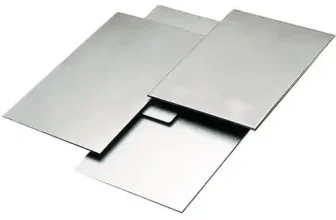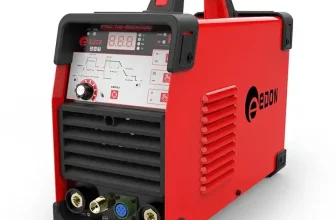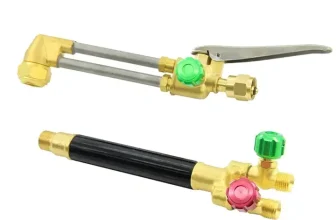Tungsten Inert Gas (TIG) welding, also known as Gas Tungsten Arc Welding (GTAW), is a high-quality, versatile welding process commonly used for precision work and in applications requiring intricate design. The process involves heating a metal to its melting point using an electric arc that is generated between the workpiece and a tungsten electrode. The heated or molten metal then fuses together to form a weld. Crucial to the TIG method is the inert gas shield, typically argon or helium, that protects the weld area from oxygen and other reactive gases in the atmosphere. TIG welding is valued for its ability to produce clean and precise welds, with minimal splatter, making it the method of choice for a range of materials including steel, aluminum, nickel alloys, copper, brass, and bronze.
Importance of Gas in TIG Welding
Gas plays a pivotal role in the process of Tungsten Inert Gas (TIG) welding. The primary function of the gas in TIG welding is to protect the electrode and the weld pool from oxidation and other atmospheric contaminants. Without the shielding gas, the quality and strength of the welds could severely depreciate. Moreover, the choice of gas also impacts the characteristics of the arc, welding speed, and the quality of the finished weld. As such, understanding the properties and uses of different gases is critical to the successful implementation of TIG welding.
Overview of Different Types of Gas
Classification of Gases used in TIG Welding
In TIG welding, there are primarily four types of gases, or gas mixtures, that are commonly used based on the welded materials’ specific nature and requirements. These gases include
- Pure Argon Gas: This is the most extensively used gas in TIG welding. Argon is a natural occurring gas which, due to its inherent non-reactive nature, makes it ideal for welding a comprehensive range of metals.
- Pure Helium Gas: Less popular than Argon, Helium is nonetheless essential in certain welding situations. Its utilization is favourable due to its higher heat generation capability than Argon, making it optimal for thicker materials.
- Argon-Helium Mix: Sometimes, the mix of Argon and Helium is preferred. This mixture combines the benefits of both gases, increasing the welding process’s versatility. The ratio can be varied as per specific requirements, creating a flexible solution for different settings.
- Argon-Hydrogen Mix: This mix is suitable for stainless steel welding. Hydrogen’s inclusion enhances the heat output of Argon, promoting cleaner welds with increased precision and speed.
Each of these gases, or gas assortments, have specific roles and uses in TIG welding, which we will delve into in the subsequent sections.
Role of Each Type of Gas
Each type of gas used in TIG welding plays a unique role in determining the welding performance and results. These gases mainly act as a shield to protect the molten metal from the atmosphere, preventing oxidation and contamination in the weld pool. They help maintain the temperature and create the necessary arc stability to produce high-quality and clean welds with minimal spatter.
Argon, the most commonly used gas, generates a smooth and stable arc and ensures high-quality welds, making it suitable for most metals. However, it offers somewhat modest penetration, especially in thicker materials.
Helium, on the other hand, generates higher heat due to its higher ionization potential, leading to greater welding speeds and better penetration. But it’s harder to start and maintain an arc with helium, besides it being more costly.
Argon-helium mixes combine the beneficial properties of both gases, providing a balanced and adjustable welding performance depending on the proportion of each gas in the mix. It’s utilized when greater penetration or welding speed is desired than pure argon can offer.
Argon-hydrogen mixes are primarily used for welding stainless steel or other similar alloys. The addition of hydrogen into argon increases the heat input, enhancing the welding speed and penetration. But this combination can be potentially dangerous and is not suitable for welding non-ferrous metals.
Each type of gas, therefore, has a unique role in controlling the heat, arc stability, and metal penetration, influencing the quality and efficiency of TIG welding. Hence, the selection of gas depends largely on the welding requirements.
Pure Argon Gas
Explanation of Argon Gas
Argon gas is a colorless, odorless, and tasteless noble gas present naturally in the atmosphere. It’s the third most abundant gas on Earth, making up about 0.93% of our planet’s atmosphere. As a noble gas, Argon features a full electron shell, virtually making it inert and extremely stable. This gas doesn’t easily form compounds with other elements, and it doesn’t participate in chemical reactions under standard conditions. This trait makes argon highly desirable in applications that require a non-reactive environment. It exists as single atoms, denoted by its chemical symbol Ar on the periodic table, and it’s categorized under Group 18 elements, known as the noble gases. As it is inert, argon gas has no observed toxic properties and presents minimal environmental impact, provided it is handled correctly.
Use of Argon in TIG Welding
Argon gas plays a vital role in the process of TIG welding and is commonly used due to its beneficial properties. Pure Argon is incredibly effective when working with non-ferrous metals like aluminum and magnesium, as well as stainless steel. It helps to generate a stable and easy to control arc, making it suitable for a broad range of materials and thicknesses. This gas type is also preferred for its versatility, allowing welders to use it on a wider scale in different welding applications.
In TIG welding, the Argon gas forms a protective invisible layer around the welding arc, preventing the hot metal from oxidizing and deteriorating due to contact with air. The electrode and molten metal area are safeguarded during the welding process, resulting in cleaner and higher-quality welds. Furthermore, Argon’s low thermal conductivity provides increased heat concentration at the welding arc, improving the overall welding speed. Regardless of the material being welded, Argon tends to produce a smooth, spatter-free weld bead with excellent cosmetic appearance. Hence, Argon is the go-to choice for TIG welders focusing on precision and finesse.
Pros and Cons
Argon stands as the go-to choice for many TIG welders due to several advantages. Foremost, it provides excellent arc stability, which is critical for producing clean, spatter-free welds. Argon also helps in producing high-quality welds on a wide variety of metals, including steel, aluminum, and others precious metals.
Argon’s heavy nature makes it able to blanket the weld more effectively, preventing the molten weld pool from being contaminated by atmospheric gases. This factored with its ability to help concentrate the heat of the arc into a small area allows for deeper penetration into the material being welded.
Despite the positives, there are a few drawbacks to the use of Argon. One of these is its cost, as Argon tends to be more expensive than other gases used in TIG welding. Another downside is while it provides deep penetration, the overall speed of welding is much slower compared to other options like helium or mixed gas combinations. This could result in a lengthier project completion time.
Pure Helium Gas
Explanation of Helium Gas
Helium gas is a colorless, odorless, tasteless, non-toxic, and the second lightest elemental gas after Hydrogen. It belongs to the noble gas group of the periodic table and is the second most abundant element in the universe. One of the interesting facts about Helium is its very low boiling and melting points, which are lower than any other known substance. Helium is monatomic, meaning it remains as individual atoms rather than forming molecules with other atoms. Additionally, it is characterized by a high thermal conductivity, which can influence the arc temperature and the heat input during the TIG welding process.
Use of Helium in TIG Welding
In Tungsten Inert Gas (TIG) welding, helium is often used as an alternative shielding gas. It serves as a protective blanket, minimizing the risk of unwanted reactions with the atmosphere during the welding process. Crudely put, helium behaves like a bodyguard for the weld pool against contamination.
Helium’s primary characteristic that makes it advantageous in TIG welding is its high thermal conductivity. This property allows helium to contribute a larger heat input to the welding pool compared to other common shielding gases, subsequently producing a broader, deeper weld pool – a valuable asset when welding thicker materials. This can also result in faster welding speeds, making helium an efficient gas choice.
Moreover, helium’s ionization potential also plays a significant role in TIG welding. With a high ionization potential, it can produce a higher arc voltage, leading to greater heat and facilitating the ability to weld thicker materials. This makes helium particularly suitable for welding metals that require high heat input like copper and aluminum.
The use of helium is not restricted to these applications alone. It can be used in a wide range of TIG welding operations, differing in factors such as material thickness and composition, desired weld characteristics, and production speed. Whether used alone or in conjunction with other gases, the role of helium in TIG welding is undoubtedly significant.
Pros and Cons
Helium’s pros in TIG welding are multiple. For starters, it offers a hotter arc than argon, which allows for faster welding speeds and higher heat inputs to the metal being welded. This makes it ideal for welding thicker materials. It also works well with materials that conduct heat rapidly, like copper and aluminum, as it offers deep penetration into the base metal. Furthermore, the hot arc produced by helium results in better weld pool fluidity, providing a cleaner, smoother finish.
On the flip side, there are some cons to using helium. The hotter, more intense arc can lead to an increase in the risk of burn-through, especially in thin metals. This means that better control and technique are needed when using this gas. It also does not provide as stable an arc as argon, making it a bit more challenging to work with for beginners or less experienced welders. Lastly, it’s more expensive and less densely available (in its pure form) than argon, elevating costs and potentially extending project timelines due to its procurement.
Argon and Helium Gas Mix
What Argon and Helium Mix is
An Argon and Helium mix is a combination of two noble gases that are often used in TIG welding processes. This blend combines the features of both Argon and Helium gases to create a mixture that offers unique benefits. Typically, the mix consists of around 75% Argon and 25% Helium, but this can vary depending on the specific welding application. The density of Helium is less than that of Argon, but its thermal conductivity is much higher. Therefore, when mixed with Argon, Helium provides a hotter arc which is advantageous for welding certain types of metals. This blend can enhance the speed and quality of welding procedures, making it a popular choice for many welders.
Use of Argon and Helium Mix in TIG Welding
An Argon and Helium Gas Mix is extensively used in TIG welding due to its unique characteristics and powerful performance capacity. This gas mixture brings together the desirable properties of both Argon and Helium gases, providing a superior quality weld.
In terms of welding thinner materials, the Argon-Helium mix proves advantageous due to the lower ionization potential of helium. This allows the welding arc to start more easily, hence making the initial process smoother.
When welding thicker materials, the high heat property of helium in this mix is helpful. As helium carries more heat than argon, it offers better penetration into the weld, which is essential in welding heavier sections.
Furthermore, the mix of Argon and Helium together improves the welding speed. This mix facilitates faster travel speeds when compared to pure Argon, boosting productivity in the welding process.
Overall, the blend of Argon and Helium offers flexibility in the TIG welding process, and this diverse range of benefits makes it a popular choice for a broad range of applications.
Pros and Cons
The Argon and Helium Gas Mix presents various advantages in TIG welding. One primary advantage is the reduced distortion rate due to the cooler heat input that Argon provides, while the helium contributes to deeper penetration and improved weld quality. This mixture can be used on thicker materials and for applications that require high-quality welds. It also promotes faster welding speeds and is perfect for overcoming convoluted welding positions due to its superior arc stability and start characteristics.
However, there are certain drawbacks to using this combination. The cost factor comes into play – helium is significantly more expensive than argon, raising the overall expense of the welding operation. Also, due to helium’s higher thermal conductivity, there might be a need for higher amperages to achieve the same heat input compared to pure argon, which can lead to increased power consumption. Additionally, one might also find differences in handling characteristics when switching from pure Argon to a Helium mix, creating a steeper learning curve for some welders. Lastly, helium can be a bit challenging to source in certain regions, making it a less practical option for some.
Argon and Hydrogen Gas Mix
Explanation of Argon and Hydrogen Mix
Argon and Hydrogen mix is a blend of two gases commonly used in TIG welding. It typically consists of a high percentage of Argon, up to about 95%, with the remaining percentage being Hydrogen. Argon, a noble gas, brings stability to the welding arc, while hydrogen, a reactive gas, contributes to the heat output. The inclusion of hydrogen, despite being a small percentage, plays a critical role. It increases the heat input of the welding arc, assisting in better penetration and faster welding speeds. This mixture of Argon and Hydrogen also results in a cleaner weld, as the hydrogen helps in removing oxides from the weld pool. It’s important to understand that the ratio of Argon to Hydrogen in the mixture can be adjusted based on the specific welding requirements.
Use of Argon and Hydrogen Mix in TIG Welding
The combination of argon and hydrogen serves a unique purpose in TIG welding, especially when dealing with certain types of metals. The mixture is often used when welding austenitic stainless steel and nickel-based alloys. Argon serves as the base, offering reliable arc stability, contamination coverage, and efficient heat transfer.
The inclusion of hydrogen, however, enables a hotter arc, permitting greater welding speeds and improved penetration. By running hotter, it helps to alter the arc characteristics in such a manner that it prevents the formation of oxides, hence reducing porosity in the welding.
It’s essential to note that hydrogen is not compatible with all materials due to its potential to cause hydrogen embrittlement. Thus the use of this mixture is more limited compared to pure argon or a blend of argon and helium.
The argon-hydrogen blend is typically found in ratios varying from 95% Argon / 5% Hydrogen to 75% Argon / 25% Hydrogen, depending on the desired weld properties. The choice of the right blend depends on the specific project at hand, requiring experimentation to establish the optimum gas proportions.
Pros and Cons
Argon and hydrogen mixed gases bring several benefits, but also present some challenges in TIG welding. Let’s delve into both sides of the aisle.
Starting on a positive note, a marriage between argon and hydrogen can lead to increased welding speeds. This is due to the high heat output of hydrogen which aids in faster material melting. Moreover, this mix can improve weld penetration, particularly in metals like stainless steel. It delivers cleaner welds as the hydrogen helps eliminate oxidation. A combination of these gases can also be a more cost-effective solution in certain instances, as it may require less power due to the increased heat output.
However, there’s no denying that this mix has its share of drawbacks. The most pivotal is the risk involved when working with hydrogen, a highly flammable and potentially explosive gas. Therefore, stringent safety measures need to be incorporated when handling this gas mix. Volatility aside, hydrogen can also cause issues like porosity in the weld bead, especially in materials that are sensitive to hydrogen embrittlement such as high-strength steels. It is not ideal for working with certain metals, including aluminum and magnesium, due to the potential for hydrogen cracking. Lastly, this gas combo isn’t favorable for thick metals as it might lead to a lack of fusion.
The presence of pros and cons means that using an argon and hydrogen mix for TIG welding needs a balanced approach, whereby the potential gains are weighed against the possible shortcomings. To this end, safety protocols and material compatibility should be a significant contributor to using this mix confidently and efficiently.
Selection Guide for TIG Welding Gas
Factors to Consider
Choosing the right gas for TIG welding involves several factors. First and foremost, the type of metal you are welding is a key determinant. Argon gas is typically used for thinner metals such as aluminum and stainless steel. Conversely, helium gas is better suited for thick metal sections as it generates more heat.
The required welding speed also plays a role. For instance, if you’re aiming for faster welding speeds, helium or a helium-argon mix would be your best bet due to their higher heat generation capabilities.
Another factor is the weld quality you desire. If you’re striving for a clean, precision weld, a pure argon gas is a highly suitable choice because it results in a more stable arc and less spatter.
The cost might also be a consideration. Different types of gases vary in price, with pure helium often being more expensive than argon.
Finally, consider the application’s safety requirements. For example, argon-hydrogen mixtures should not be used in confined spaces or on parts that will be exposed to high stress or pressure due to its susceptibility to causing hydrogen embrittlement.
By understanding and factoring in these considerations, you can make an informed choice about the best gas for your TIG welding projects.
Best Gas for Different Metals
When it comes to selecting the best gas for welding different metals, a few key factors should be considered.
For aluminum and magnesium alloys, pure Argon is often the best choice. Argon offers a stable arc and excellent cleaning action for these types of metals, which can be particularly beneficial if the material is oxidized.
For welding thicker materials and copper alloys, Helium or an Argon-Helium mix is typically considered the best option. Helium helps to increase heat input, which can consequently provide deeper penetration and faster travel speeds. This makes it particularly useful for thicker materials that require deeper welds.
For welding stainless steel and other corrosion-resistant alloys, an Argon-Hydrogen mix is commonly recommended. Hydrogen significantly increases the heat input, enhancing the fluidity and penetration of the weld.
Hydrogen should be used with caution on certain materials to avoid hydrogen-induced cracking. Always refer to the manufacturer’s guidelines and seek expert advice when selecting gases for different metals to ensure the optimal welding performance.
Conclusion
Importance of Correct Gas Selection
Selecting the right gas is of paramount importance in TIG welding process. The choice of gas significantly determines the overall quality and efficiency of the work, making it a critical aspect of the entire process. For instance, the extent to which the welding arc is stable, the level of spatter, the overall weld appearance, and the penetration characteristics are all affected by the type of gas used.
The different types of gases have their specific strengths and weaknesses that can suit different materials and varied welding conditions. Therefore, understanding these properties and making the correct choice ensures not just a smooth welding process, but also generates optimal results. It’s not a one-size-fits-all scenario, and that’s where the value of technical knowledge and understanding comes in.
In line with that, the right choice of TIG welding gas carries economic implications as well. The correct gas leads to efficient use of time and resources which translates into cost savings in the long run.
The significance of proper gas selection in TIG welding should not be underscored. It remains a fundamental variable that welders should give utmost consideration to ensure the delivery of high-quality welding work.
Recap of Different Gas Types and their uses
Over the course of this article, we’ve delved into the different types of gases used in TIG welding and their specific applications. To start with, we explored pure Argon gas, the most commonly used shielding gas, which is excellent for welding most types of metal due to its low penetration and low heat input.
Next on our list was pure Helium gas. Known for its high heat input, it’s particularly effective for welding thick materials and metals with a high heat conductivity, like copper and aluminum.
We then ventured into mixtures, beginning with the Argon and Helium blend. This mix combines the best qualities of both gases, thus improving the welding speed and penetration.
Finally, we delved into the Argon and Hydrogen mix, primarily suited for welding austenitic stainless steel. This mixture is often favored for its high conductivity and deep penetration characteristics.
By selecting the right gas or gas mixture, you can significantly influence the success, speed, and result of your TIG welding process. Therefore, understanding the specific applications and effects of these different gases is essential for producing high-quality welds.
Final Thoughts on Gas Selection and TIG Welding Performance
The gas selection process may seem intricate but is pivotal for achieving optimal TIG welding performance. The intricate fusion of gas, heat, and metals takes practice, and with the right gas choice, the practice can translate into perfect welds. Whether it’s the broad application of pure Argon, the deep penetration offered by Helium, or the versatility of Argon-Helium and Argon-Hydrogen mixes, each type of gas comes with its strengths and tradeoffs.
Remember, there’s not a one-size-fits-all solution with TIG welding gases. Your choice will often depend on the specific weldment, heating needs, and desired weld characteristics. It may sometimes feel daunting, but don’t hesitate to experiment with different gases or gas mixtures and find what works best for your specific welding needs.
While TIG welding can indeed be challenging, with the right gas selection, it can deliver precise and high-quality welds proving time and time again why it’s valued by many industries worldwide.







